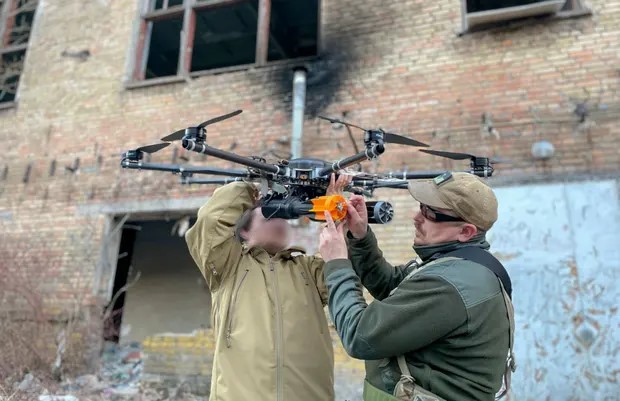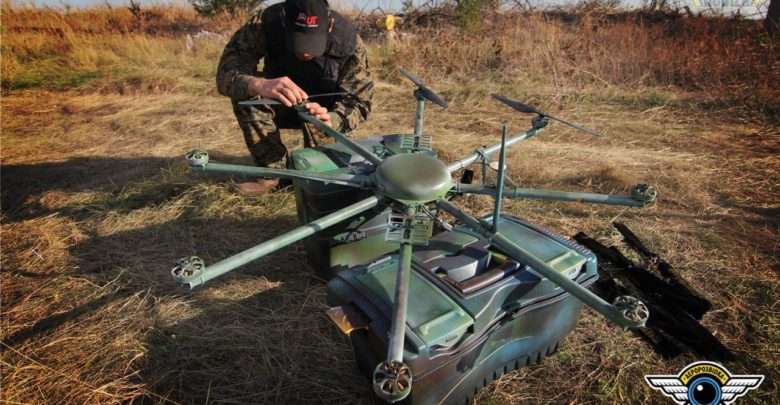A small Ukrainian unit seems to have distinguished itself during the recapture of Hostomel airport on 25 February and during the stopping of the "60 km column" northwest of Kiev. This unit has quads, snipers, personnel trained in the use of night vision binoculars and, above all, very light drones modified for reconnaissance and bombing.
Aerorozvidka
In 2014, while Russia was carrying out a coup over part of the Donbass and Crimea, several Ukrainian computer and drone enthusiasts banded together with the aim of developing small-scale drones for the Ukrainian Army. They are designed for combat and reconnaissance and based on drones available on the civilian market. The group is disbanded in 2019 because the Ukrainian General Staff does not see the usefulness of these drones in case of high intensity combat. The collective does not separate and launches a participatory financing. This allows it to continue its research and development of drones.
In late 2021, faced with rising tensions, the group is reactivated [sources vary between militia and active unit] and commanded by Lieutenant Colonel Yaroslav Honchar. The drones, however, have nothing to do with small commercial drones, as they now make their own drones, some of which can carry two 1.5 kg bombs and have a targeting system built into the camera.
The group resembles a commando unit; small numbers (about 30), movement by quad bike, members are trained in the use of night vision binoculars, there are also snipers and personnel trained in the use of explosives. The name Aerorozvidka means "aerial reconnaissance" in Ukrainian.


First action: the counterattack on Antonov airport
On the afternoon of February 24, the Russians launched a helicopter assault on Hostomel/Antonov airport. After suffering several casualties before arriving at the airport, the Russian paratroopers managed to secure the area. The Aerorozvidka unit was then deployed on the ground to support the Ukrainian counter-offensive. The UAVs thus made it possible to locate the various Russian support points, to direct artillery fire or even to bomb the Russians directly using UAVs. The airport will be retaken the next morning and the Russian paratroopers will even be pursued in their retreat by the drones.
Second blow: raids on the 60 km column
On February 25-26, fighting begins in the outskirts of the capital, which seems to be holding. On February 28, satellite images of a column stretching 60 km long began to emerge. It seemed to be heading towards Kiev, but its route was not direct. Indeed, during their retreat on Kiev, the Ukrainians built many obstacles, anti-tank traps and above all, destroyed several strategic bridges. This does not prevent the column from advancing little by little.
A few days after this discovery, the column seems to be completely stopped. Ukrainians managed to destroy several vehicles in front of it with a combination of anti-tank weapons and drones from the Aerorozvidka unit. This unit will not stop there as it will pull up the column at night and carry out harassment raids: targets of interest, special vehicles and even a logistics depot will be destroyed.
The column will then accumulate other problems; it will be cut off from its logistical flow (lack of water, food and fuel), the poor quality of the tires purchased in China will significantly increase the need for spare tires, the rasputitsa that will prevent any movement through the fields, etc. The column will eventually be separated into several small convoys.
A major weakness: the pilot-drone link
Since the beginning of the invasion, the internet network in Ukraine is not cut off, but is severely disrupted. The Deputy Prime Minister and Minister of Digital Transition Mykhailo Fedorov will then send Elon Musk a tweet (available below) to be able to use the Starlink satellite constellation. The same evening, Elon Musk responded to this tweet by announcing that Starlink was available everywhere in Ukraine. We will learn that in mid-March, about 6,000 stations had been delivered in Ukraine. They have been distributed to civilians but also to military units requiring long distance communication such as artillery. The Aerorozvidka unit also received Starlink stations because the drones communicate with the pilot via an internet link.
The Russians did try to jam the Starlink system directly but the cyber security of the network was greatly increased. The Russians then decided to jam the drones used by the Aerorozvidka unit. These drones are not designed to fly in a jammed area and are therefore lost. However, the unit also receives new drones and modifies, as in the beginning, commercial drones. Finally, the Russian jamming systems are not disseminated among all deployed units, allowing the redeployment of the Aerorozvidka unit to another area.
Découvrez cet article sur Air&Cosmos

